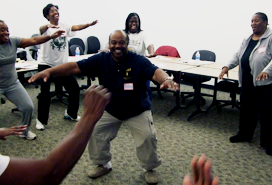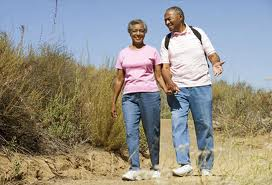Topics
Additional health advice:
10 Tips for Physical Activity
-
Regular physical activity is healthy and can be fun! Being more active is very safe for most people. However, some people should see their doctor before starting a physical activity program.
 If you have been inactive (doing little to no physical activity) for a long time or have a chronic health condition (e.g. heart disease, diabetes) talk with your doctor BEFORE becoming more physically active. You may need to limit your activities to those which are safe for you. Talk with your doctor and follow his/her advice. To assess if you are ready for physical activity, complete the Physical Activity Readiness Questionnaire (PAR-Q).
If you have been inactive (doing little to no physical activity) for a long time or have a chronic health condition (e.g. heart disease, diabetes) talk with your doctor BEFORE becoming more physically active. You may need to limit your activities to those which are safe for you. Talk with your doctor and follow his/her advice. To assess if you are ready for physical activity, complete the Physical Activity Readiness Questionnaire (PAR-Q). You may be able to do any activity you want – as long as you start low and go slow. Gradually build up the intensity and duration of your physical activity over time. Perform lower intensity activities (e.g. walking briskly) before increasing to more strenuous ones (e.g. walking up hill). Aim for smaller bouts of physical activity. Instead of a 30-minute continuous walk, try to walk for 10 continuous minutes three times per day. Download a sample walking program today and be on your way to a healthy start!
Choose activities that you find fun. Picking simple, enjoyable physical activities that match your abilities and interests will help you to stick with them. Having a variety of activities that you like will help, so that you don’t become bored over time. Be sure to choose a number of activities that are personally enjoyable to you, such as walking, sports, or gardening. Don’t know what you like? Not to worry! For a list of activities you can choose from, CLICK HERE.
-
Wear proper attire, such as loose-fitting clothes and appropriate shoes. Try to wear clothes made of breathable fabrics that allow sweat to evaporate quickly from your skin. Consider lightweight, light-colored, and airy clothing during warm temps. During colder times, try layering for added warmth. Invest in shoes that provide the necessary support for your body, as this will decrease muscle and joint stress in your feet, knees, and back. Picking the proper shoes can prevent discomfort and injury and will encourage you to maintain an active lifestyle.
Be active with others.
 Did you know that being active with friends helps some people better stick to physical activity? Studies show that partnering with others can make a difference! Sometimes it seems hard to keep up with healthy goals that we set for ourselves, especially if we think we must reach them on our own. We are more likely to stay motivated and keep healthy habits with the support of others. Choose to move together! Share physical activity goals to support each other to stay on track with healthy choices. For more information about starting a buddy system, CLICK HERE.
Did you know that being active with friends helps some people better stick to physical activity? Studies show that partnering with others can make a difference! Sometimes it seems hard to keep up with healthy goals that we set for ourselves, especially if we think we must reach them on our own. We are more likely to stay motivated and keep healthy habits with the support of others. Choose to move together! Share physical activity goals to support each other to stay on track with healthy choices. For more information about starting a buddy system, CLICK HERE.-
Stick with it. Having trouble sticking with your physical activity plan? Don’t be discouraged. Even if you have taken a break or have not been as active as you would like, long term physical activity is for the lifetime. Find a convenient time to be active. Try to fit some activity into your daily schedule by blocking off the same time each week. The good news is that you don’t have to have a gym membership or expensive equipment. Try simple things to increase your physical activity such as taking the stairs, parking a bit further away, or cleaning the house are great ways to move your body and improve your health. For a list of more ways to build activity into every day, CLICK HERE.
-
Know when to stop. Physical activity is safe and recommended for most people. However, like most good things, physical activity can be risky if proper safety precautions are not taken. Stop your physical activity right away if you experience:
- pain or pressure in your chest, neck, shoulder or arm,
- sharp pains in your joints, feet, ankles or legs,
- dizziness or nausea,
- cold sweats, or
- muscle cramps.
Slow down if you become very out of breath. You should be able to talk while being active without gasping for air. Also think of the safety of your environment. When being active outdoors, monitor for safety: traffic, pavement, weather, stray animals, and strangers. For more tips on safety precautions for physical activity, CLICK HERE.
-
Set goals. Setting goals is an important part of making healthy lifestyle changes. Take time to set short-term and long-term physical activity goals. Short-term goals are those that you will want to achieve in the near future. They should be small, easy to achieve, and move you closer to your long term goals. For example, a short term goal can be, “Next week I will walk for 15 minutes, on 3 days”. Long term goals, however, may take months or even longer to achieve. For example, a long term goal can be, “In six months, I will walk 30 minutes a day, 5 days a week”. Short-term goals are very important for keeping you motivated and focused on your long term goals. Change takes discipline. By tracking your activity, increasing it little by little, and finding solutions for barriers, you will be well on your way to meeting your goals. Download a goal setting worksheet to get started today!
Reward yourself for healthy habits! Self-reward is an incentive you offer yourself for being active, making progress toward and reaching your physical activity goals. It is important to reward yourself. Rewards make you feel better about yourself and your success and they also encourage you to continue to work towards your goals. Nothing motivates like success! Buy a pedometer (step counter) to reward regular walking or a beautiful new pen to reward tracking your goals and monitoring your physical activity. For additional ideas, visit: http://ezinearticles.com/?10-Great-Rewards-For-Sticking-to-Your-Exercise-Plan&id=2060995
-
Warm up and cool down. It’s important to spend about 5 minutes at the beginning and end of your routine to warm up and cool down. Warming up and cooling down give your muscles a chance to get ready to work and gradually return to rest at the end. These “before-and-after” activities help prevent injury and reduce muscle soreness later. A few suggestions for warming up properly are: (1) do some light aerobic activity first, such as walking for 5 minutes or if you’re going to be walking briskly, gradually build up to that pace, and at the end of your activity, gradually slow down and let your body cool down; (2) do a few light activities to work the muscles and joints you’ll be using in your activity; (3) if you plan to include stretching exercises, be sure to do them at the end of your physical activity routine. For more stretching tips, CLICK HERE.